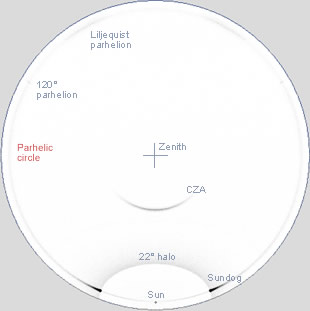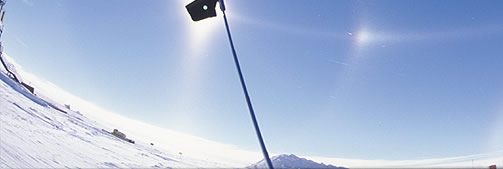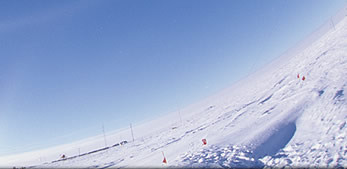
OPOD
What's New
Rays & Shadows
Water Droplets
Rainbows
Ice Halos
Contents
Crystals
Frequent Halos
22° circular
Sundogs
Tangent Arcs
Circumscribed
Pillars
Circumzenithal
Circumhorizon
Parhelic Circle
Formation
Low Sun
High Sun
More Images
Infrequent Halos
Multiple Displays
Other Worlds
Observing Halos
HaloSim
High Atmosphere
Links & Resources
Search - Index
123456789012345678
| Parhelic Circle - Low Sun |
 |
||
|
| Parhelic Circle at the South Pole imaged by Marko Riikonen 11th January 1999 at 0500hrs. The parhelic circle swings through the 22° high sun, brightens outside the sundogs and hugs the flat horizon everywhere at the same height. Image ©Marko Riikonen. |
 |
Parhelic Circle for 22° high sun Sweeping around the horizon, the circle is not uniformly bright. It is fainter through the sun and inside the sundogs where it relies primarily on rays reflected externally. The halo also becomes faint beyond the 120° parhelia. At these angles, internal reflections become less efficient. HaloSim ray tracing. Fisheye view centered on the zenith, 40% randomly oriented columns to produce the 22° halo and 60% plate crystals with c/a=0.05. |
||
 |
Very low sun Here the sun is only 5° above the horizon. Again, the parhelic circle is faint beyond the 120° parhelia - then it brightens again.. The two bright regions 150 to 160° from the sun are Liljequist parhelia first observed in Antarctica by the Swedish meteorologist G.H. Liljequist. Almost perfect hexagonal plate crystals are needed to form them. Their ray paths involve two internal reflections. An example is a ray entering face 3, reflecting off faces 7 then 6 to exit through face 8 (path 3768 see face number key). There is net refraction in this ray path and the Liljequist parhelia are slightly coloured. |
||
 |
40° high sun Contrast the parhelic circle as the sun climbs higher. The rays strike internal vertical faces more obliquely and are more efficiently reflected. The circle becomes more uniform. |

